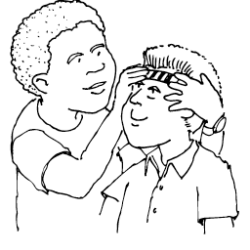Source Institutions
Source Institutions
Add to list Go to activity
Activity link broken? See if it's at the internet archive

This activity (on pages 16-23) lets learners measure each other's vital signs—the signs that help doctors understand what's going on in a patient body. Learners measure human body temperature, respiration rate, and pulse, and compare them to vital signs of other mammals large and small, such as a cow and a rabbit. A "think it over" writing exercise finishes the activity.
- 10 to 30 minutes
- 45 to 60 minutes
- $1 - $5 per group of students
- Ages 8 - 14
- Activity
- English, Spanish
Quick Guide
Materials List (per group of students)
- thermometer strips
- clock or watch for timing seconds
- pencil
- Optional: 2 pinches of modeling clay (marble-size)
- Optional: 2 toothpicks
Subjects
-
Life Sciences
-
Diversity of Life
- Animals
-
Human Body
- Muscles and Skin
- Circulation
- Health and Nutrition
- Medicine
-
Human Senses and Perception
- Touch
-
Diversity of Life
-
The Nature of Science
-
The Scientific Process
- Gathering Data
-
The Scientific Process
Audience
To use this activity, learners need to:
- see
- touch
Learning styles supported:
- Involves teamwork and communication skills
- Involves hands-on or lab activities
Designed specifically for
- Rural dweller
Culture, ethnicity, and gender
-
Girls
- Explicity developed for this group
Other
Foreign language versions of this resource:
Components that are part of this resource:
Includes alignment to state and/or national standards:
This resource is part of:
Access Rights:
- Free access
By:
- University of Nebraska State Museum; Nebraska Cooperative Extension 4-H Youth Development
Source Collection
- Science After School Consumer's Guide
Rights:
- All rights reserved, University of Nebraska State Museum, 2002
Funding Sources:
- National Science Foundation Informal Science Education Program, 9909496
- Howard Hughes Medical Institute
